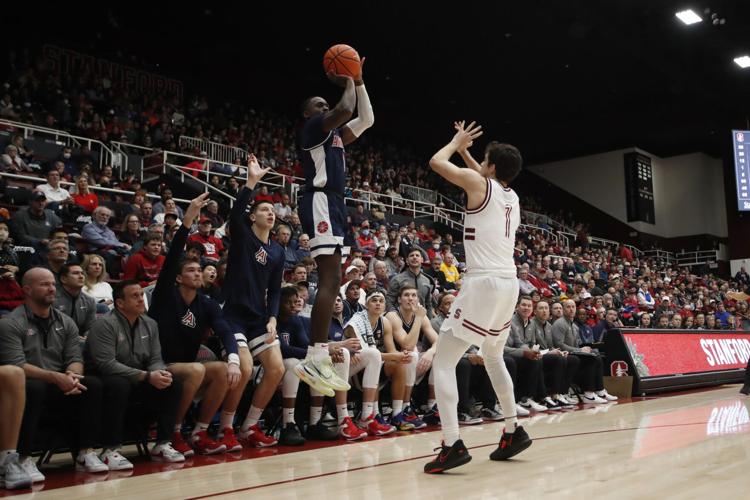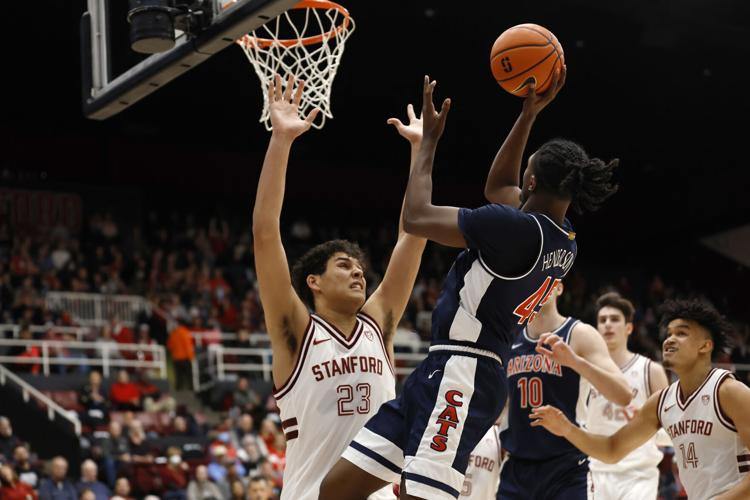STANFORD, Calif. — Courtney Ramey has been a starter for nearly five full seasons of college basketball, and he’s never made 3-pointers as often he did Saturday.
That was the problem.
It wasn’t just that No. 4-ranked Arizona lost to Stanford 88-79 at Maples Pavilion on Saturday despite Ramey’s career-high eight 3-pointers. It was also that Ramey felt he had to hit those eight 3s, had to throw up 16 long-range attempts, on a team that is normally powered inside-out. Not outside-and-maybe-in.
Something was wrong, and Ramey knew it. Arizona’s potential Pac-12 Player of the Year, forward Azuolas Tubelis, was in foul trouble and the Wildcats weren’t able to find him or normally efficient center Oumar Ballo very often, either.
Ballo and Tubelis combined to take just seven shots.
Ramey took 18, including the 16 from beyond the arc.
“When you have the player of the year and you have Oumar, who’s first-team all-conference, why not see what happens?” Ramey said. “Why not put pressure on them? We got some bad whistles but they’re our two best players, so why not try to get them going?
“Yeah, I hit eight 3s. But I’d rather see them going and getting layups and fouls, than me shooting. I don’t know how many 3s I shot but that’s something I will fix.”
Well, Ramey probably doesn’t need to fix the percentage. He did hit half of those 16 3s, after all.
But the volume bothered Ramey and UA coach Tommy Lloyd, too. Kerr Kriisa threw up 10 3s and hit three of them, while Cedric Henderson was 2 for 6.
Overall, Arizona was 14 for 35 from 3, setting season highs for makes — and attempts — from beyond the arc.

Arizona guard Cedric Henderson Jr. shot from close range here, but he also took six of UA’s 35 3-point attempts in the loss.
“I just don’t know if that’s a winning formula for us,” Lloyd said.
Ramey agreed. When he was asked in the Stanford media room about what kind of zone he was in as a shooter, Ramey flipped the question over.
“They did a good job of taking away our bigs,” Ramey said. “I just shot the ball. (Teammates) did a good job of finding me in open spots. But being a leader, I should have just told everybody to get the ball down low. We shot 35 3s and that’s not going to win us a lot of games.”
Both Ramey and Lloyd said Stanford did a good job of switching defensively, with their many similarly sized big wings able to guard multiple positions, and there was no doubt that made things tougher for Ballo and Tubelis to break away.
While Stanford coach Jerod Haase noted dryly that his game plan “did not include 14 made 3s from them,” his strategy ultimately paid off. Stanford outscored Arizona 42-24 in the paint and outrebounded the Wildcats 34-26. The Cardinal also scored 14 second-chance points on 10 offensive rebounds, scooping up more than half of its 18 missed field goals.
Stanford ultimately became even more efficient than one of the country’s most efficient offenses, shooting 61.1% overall and hitting 10 of 18 3-pointers.
“I thought we really did a nice job most of the game keeping the ball out of the paint,” Haase said. “Look, they have big-time players and on the inside, if they get paint touches there’s nobody in the country that’s going to stop those guys. So you’ve got to find a way to way to limit the touches inside.”
While Ramey and Lloyd gave Stanford plenty of credit, Ramey said he could have helped by reacting more effectively to it.
“Me being a leader, I could have just gave them one extra post touch, or just told them to keep sealing or tell then to keep rebounding,” Ramey said. “That’s something I will fix next time.”
On the other side of the court, the Wildcats also found some things to work on Saturday. Although Ramey is one of the Wildcats’ best defenders, he wasn’t able to help stop the Cardinal’s big wings from getting inside and also shooting over the Wildcats. While Arizona made many of Stanford’s shots difficult, the Cardinal still made many of those and took advantage of the few open looks it got.
“I’m not going to take credit away from them but we had some (defensive) breakdowns,” Lloyd said. “We just made some crazy decisions at the end of a shot clock and gave them a shot or an advantage when I didn’t think they needed to have that.
Moreover, while the Wildcats kept Stanford forward Spencer Jones scoreless in the first half, Jones reverted to the same guy who poured in 28 points against them in the Pac-12 Tournament quarterfinals last season.
That is, Jones scored 18 points on 8-for-13 shooting after halftime.
“I could tell early on their their game plan was trying to just not let me get the ball,” Jones said. “I’ll look at the tape and see if I could have been more aggressive. But we were rocking on offense, so I didn’t feel the need to (score). But in the second half, I knew I was gonna have to put up the performance to maintain our lead and win this game.”
Stanford finished with five players in double-figure scoring while Arizona’s unbalanced offense had Ramey with 26 points, three others with double digits and, again, only seven total contributors.
After the game, Lloyd said he was comfortable with just his usual seven guys, even when asked if he considered inserting freshman bigs Henri Veesaar or Dylan Anderson to help out inside.
“I feel like we played the right guys,” Lloyd said. “I wish ’Zu would have got to play a little bit more. We’ve just got to play better. We’ve got to play smart.
“I think we go back and watch that film, and we’re gonna see a lot of self-inflicted wounds and Stanford was good enough to take advantage of those.”






